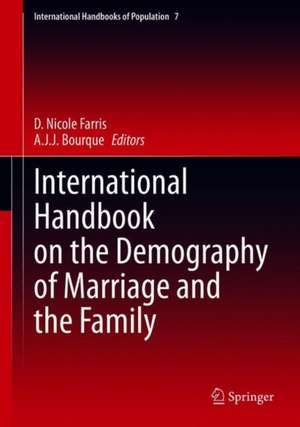International Handbook on the Demography of Marriage and the Family: International Handbooks of Population, cartea 7
Editat de D. Nicole Farris, A. J. J. Bourque Contribuţii de Karista K. Hughes, Elizabeth Harmon Threatten Limba Engleză Hardback – 4 apr 2020
Coverage is centered around four main sections that present a history of marriage and the family, detail relevant data and measurement concerns, examine global marriage practices, analyze interactions of such demographic characteristics as age, sex, and race with marriage and the family, and consider public policy, contemporary trends, and future directions. In addition, the book includes research on current social issues such as alternative family structures, cohabitation, divorce, boomerang children, and adoption.
The family is universal but extremely varied in form and function. This handbook provides students, researchers, and policymakers with an all-inclusive, international demographic analysis that fully investigates the diverse nature of the modern family.
Preț: 1229.10 lei
Preț vechi: 1498.90 lei
-18% Nou
Puncte Express: 1844
Preț estimativ în valută:
235.18€ • 245.55$ • 194.65£
235.18€ • 245.55$ • 194.65£
Carte tipărită la comandă
Livrare economică 04-18 aprilie
Preluare comenzi: 021 569.72.76
Specificații
ISBN-13: 9783030350772
ISBN-10: 3030350770
Pagini: 321
Ilustrații: X, 321 p. 47 illus.
Dimensiuni: 178 x 254 mm
Greutate: 0.77 kg
Ediția:1st ed. 2020
Editura: Springer International Publishing
Colecția Springer
Seria International Handbooks of Population
Locul publicării:Cham, Switzerland
ISBN-10: 3030350770
Pagini: 321
Ilustrații: X, 321 p. 47 illus.
Dimensiuni: 178 x 254 mm
Greutate: 0.77 kg
Ediția:1st ed. 2020
Editura: Springer International Publishing
Colecția Springer
Seria International Handbooks of Population
Locul publicării:Cham, Switzerland
Cuprins
Part 1: Introduction.- Chapter 1. Introduction: The Demography of Marriage and Family: D. Nicole Farris.- Chapter 2. The Demography of Marriage and Family: A History: Anna-Marie Malley, Carol S. Walther, and Karley Nichols.- Chapter 3. Defining Marriage and Families: Data and Measurement: Mary Ann Davis.- Part II: Marriage Practices: The Global Picture.- Chapter 4. Marriage Practices of North America: Bailey Wright and D. Nicole Farris.- Chapter 5. Family Forerunners? An Overview of Family Demographic Change in Sweden: Sofi Ohlsson-Wijk, Jani Turunen, and Gunnar Andersson.- Chapter 6. Parental Leave Policy Influence on Fertility Rates: The Importance of Social Contexts on German and Swedish Reform with the United States as a Reference: Philip Copeland and D. Nicole Farris.- Chapter 7. Residential Segregation and Intermarriage: Xinyuan “Karl” Zou.- Chapter 8. Marriage and Family in Turkey: Trends and Attitudes: Ceylan Engin, Hazal Hürman, and Kimber Harvey.- Part III: Marriage/Family Practices: A Closer Look: Chapter 9. Heterogeneity in Census Identification of Parent-Child Relationships Within Same-Sex Households: Amanda K. Baumle and D’ Lane R. Compton.- Chapter 10. The Social Capital of Rural Demography of Marriage, Cohabitation, and Divorce: Janet Reynolds and Carol S. Walther.- Chapter 11. Race and Marital Quality in the Context of the 2007–2009 Recession: Theresa Davidson.- Chapter 12. Effects of Educational and Metropolitan Context on U.S. Black Intermarriage: Danny Elworth Malone Jr.- Chapter 13. A Demographic Perspective on Childhood Adoptions in the U.S: Mary Ann Davis.- Chapter 14. The Non-traditional Family: Rodrigo Dominguez-Martinez, Stephanie D. Jones, and Carol S. Walther.- Chapter 15. Multigenerational Households: A Descriptive Approach to Distinctive Definitions: Guadalupe Marquez-Velarde.- Chapter 16. Boomerang Children: D. Nicole Farris.- Chapter 17. Transnational Motherhood: A Brief Introduction: A. J. J. Bourque.- Part IV: Public Policy, Contemporary Trends, and Future Directions: Chapter 18. Where Were the States? Same-Sex Marriage Before Obergefell: Brian Stephens.- Chapter 19. From Voluntarily Childless to Childfree: Sociohistoric Perspectives on a Contemporary Trend: Shelly Volsche, Shelby Schmidt, and D. Nicole Farris.- Chapter 20. The Contemporary Family: Dudley L. Poston, Jr..- Chapter 21. Future Trends in Marriage and Family: Gabe H. Miller.- Conclusion: D. Nicole Farris and A. J. J. Bourque.
Notă biografică
D. Nicole Farris is an Associate Professor of Sociology in the Department of Sociology and Criminal Justice at Texas A&M University-Commerce. Her major areas of research include gender, demography, marriage/family, and methodology. Her most recent edited book (with D’Lane Compton and Andrea Herrera), “Race, Gender, and Sexuality in the Digital Age” will be published in late 2019 with Springer Publishers.
A.J.J. Bourque is a graduate student in the field of children’s and adolescent literature in the Department of Literature and Language at Texas A&M University-Commerce. His current research interests include masculinity, the subconscious, and Jungian archetypes. Bourque is the author of two young adult novels.
A.J.J. Bourque is a graduate student in the field of children’s and adolescent literature in the Department of Literature and Language at Texas A&M University-Commerce. His current research interests include masculinity, the subconscious, and Jungian archetypes. Bourque is the author of two young adult novels.
Textul de pe ultima copertă
This handbook provides a global perspective on contemporary demographic theories and studies of marriage and the family. Inside, readers will find a comprehensive analysis that enables demographic comparison between and across international borders.
Coverage is centered around four main sections that present a history of marriage and the family, detail relevant data and measurement concerns, examine global marriage practices, analyze interactions of such demographic characteristics as age, sex, and race with marriage and the family, and consider public policy, contemporary trends, and future directions. In addition, the book includes research on current social issues such as alternative family structures, cohabitation, divorce, boomerang children, and adoption.
The family is universal but extremely varied in form and function. This handbook provides students, researchers, and policymakers with an all-inclusive, international demographic analysis that fully investigates the diverse nature of the modern family.
The family is universal but extremely varied in form and function. This handbook provides students, researchers, and policymakers with an all-inclusive, international demographic analysis that fully investigates the diverse nature of the modern family.
Caracteristici
Provides a global perspective on contemporary demographic theories and studies of marriage and the family Enables demographic comparison between and across international borders Includes research on current social issues such as alternative family structures, cohabitation, divorce, and adoption











